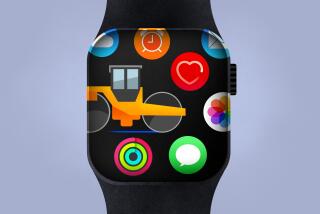Software Writers Stunned by Scope of Apple’s Suit
- Share via
SAN FRANCISCO — For the past few years, the conventional wisdom in the personal computer industry was that IBM-style personal computers would slowly but surely come to resemble the Apple Macintosh, with its snazzy graphics and point-and-click simplicity.
But last week, Apple threw a giant wrench into that scenario when it filed suit against industry giants Microsoft and Hewlett-Packard over a pair of still-unreleased software programs that, according to Apple, violate copyrights held by Apple.
Apple’s suit “has challenged all the legal and competitive assumptions of everybody in the industry,” said Stewart Alsop, publisher of the PC Letter, a Redwood City, Calif., newsletter. What just last week was taken as a given--that the IBM world was on the verge of closing the technology gap with the release of new software--can no longer be taken for granted, he said.
Released Photos of ‘Icons’
At issue is whether Microsoft’s Windows 2.03 and Hewlett-Packard’s NewWave programs, which work together to create an on-screen format that is similar to the Macintosh’s, infringe on a series of Apple copyrights. In its 11-page complaint, filed Thursday in U.S. District Court in San Jose, Apple asserted that the “artistic, aesthetically pleasing” visual displays and graphic images generated by the Macintosh were protected works under copyright law.
To buttress its argument, Apple released photos of Macintosh and NewWave computer screens that featured similar “icons,” or visual images that represent tasks, documents or applications. The Mac and NewWave also both employ a hand-held pointing device called a mouse that activates programs and moves data by selecting the various icons.
Many in the software industry were stunned by the breadth of Apple’s claims. “If Apple is trying to push this as far as they appear to be trying to push it, this is a sad day for the software industry in America,” said Dan Bricklin, the developer of VisiCalc, the first PC spreadsheet program. The mere fact that Apple has filed the lawsuit--regardless of how it is disposed of--will have a chilling effect on software writers, Bricklin argued.
Creating innovative software, he said, differs markedly from writing a novel or making a movie. “You have to build on what came before,” Bricklin said. The suit, he said, will create uncertainties for software developers working on any applications that are designed to run with Windows and may even chill developers working on Macintosh programs.
Potentially, too, it could slow development of programs that run under IBM and Microsoft’s soon-to-be-released Presentation Manager of Operating System/2, the highly touted successor to MS-DOS, the operating system used by the first generation of IBM PCs. IBM, however, said its plans wouldn’t be affected by Apple’s lawsuit, and some industry observers noted that early versions of Presentation Manager lack icons.
Apple, through a spokeswoman, insisted that the suit was narrowly targeted against Microsoft and Hewlett-Packard and “is not aimed at the developer community.”
Hewlett-Packard, for its part, charged that the lawsuit was an attempt by Apple to thwart innovative technology that “leapfrogged” the Macintosh. “The images on the screen is not what this is all about,” insisted Roy Verley, an Hewlett-Packard spokesman. Nevertheless, he accused Apple of arranging the icons on the Hewlett-Packard program to make its screen look more like the Macintosh’s in the photos released to the public. Apple denied the charge.
Microsoft, whose applications programs for the Macintosh have gone a long way in enhancing the reputation of a machine that was once regarded widely as a toy, said it was puzzled by Apple’s lawsuit.
Microsoft negotiated an agreement to license Macintosh technology for its original Windows program in 1985, and “after careful review of the complaint and the licensing agreement, Microsoft is convinced the case has no merit,” said William H. Neukom, vice president of law and corporate affairs. “Specifically,” he added, “no visual displays in Microsoft Windows 2.03 exceed the 1985 agreement.”
The 1985 agreement is likely to play a key part in what some are already calling a battle of the giants because it pits Apple’s chairman, John Sculley, against Microsoft’s brash founder William H. Gates III. In his recently released book “Odyssey,” Sculley revealed that Apple negotiated the license only after weighing--and rejecting--the idea of suing Microsoft when it first released Windows.






